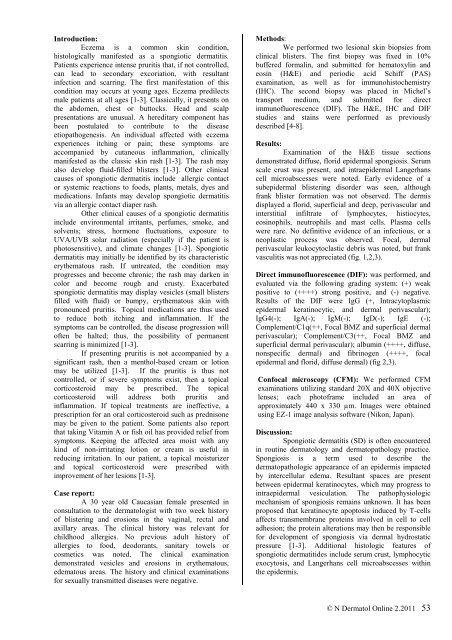2. spongiotic dermatitis with a mixed - Our Dermatology Online Journal
2. spongiotic dermatitis with a mixed - Our Dermatology Online Journal
2. spongiotic dermatitis with a mixed - Our Dermatology Online Journal
Create successful ePaper yourself
Turn your PDF publications into a flip-book with our unique Google optimized e-Paper software.
Introduction:<br />
Eczema is a common skin condition,<br />
histologically manifested as a <strong>spongiotic</strong> <strong>dermatitis</strong>.<br />
Patients experience intense pruritis that, if not controlled,<br />
can lead to secondary excoriation, <strong>with</strong> resultant<br />
infection and scarring. The first manifestation of this<br />
condition may occurs at young ages. Eczema predilects<br />
male patients at all ages [1-3]. Classically, it presents on<br />
the abdomen, chest or buttocks. Head and scalp<br />
presentations are unusual. A hereditary component has<br />
been postulated to contribute to the disease<br />
etiopathogenesis. An individual affected <strong>with</strong> eczema<br />
experiences itching or pain; these symptoms are<br />
accompanied by cutaneous inflammation, clinically<br />
manifested as the classic skin rash [1-3]. The rash may<br />
also develop fluid-filled blisters [1-3]. Other clinical<br />
causes of <strong>spongiotic</strong> <strong>dermatitis</strong> include allergic contact<br />
or systemic reactions to foods, plants, metals, dyes and<br />
medications. Infants may develop <strong>spongiotic</strong> <strong>dermatitis</strong><br />
via an allergic contact diaper rash.<br />
Other clinical causes of a <strong>spongiotic</strong> <strong>dermatitis</strong><br />
include environmental irritants, perfumes, smoke, and<br />
solvents; stress, hormone fluctuations, exposure to<br />
UVA/UVB solar radiation (especially if the patient is<br />
photosensitive), and climate changes [1-3]. Spongiotic<br />
<strong>dermatitis</strong> may initially be identified by its characteristic<br />
erythematous rash. If untreated, the condition may<br />
progresses and become chronic; the rash may darken in<br />
color and become rough and crusty. Exacerbated<br />
<strong>spongiotic</strong> <strong>dermatitis</strong> may display vesicles (small blisters<br />
filled <strong>with</strong> fluid) or bumpy, erythematous skin <strong>with</strong><br />
pronounced pruritis. Topical medications are thus used<br />
to reduce both itching and inflammation. If the<br />
symptoms can be controlled, the disease progression will<br />
often be halted; thus, the possibility of permanent<br />
scarring is minimized [1-3].<br />
If presenting pruritis is not accompanied by a<br />
significant rash, then a menthol-based cream or lotion<br />
may be utilized [1-3]. If the pruritis is thus not<br />
controlled, or if severe symptoms exist, then a topical<br />
corticosteroid may be prescribed. The topical<br />
corticosteroid will address both pruritis and<br />
inflammation. If topical treatments are ineffective, a<br />
prescription for an oral corticosteroid such as prednisone<br />
may be given to the patient. Some patients also report<br />
that taking Vitamin A or fish oil has provided relief from<br />
symptoms. Keeping the affected area moist <strong>with</strong> any<br />
kind of non-irritating lotion or cream is useful in<br />
reducing irritation. In our patient, a topical moisturizer<br />
and topical corticosteroid were prescribed <strong>with</strong><br />
improvement of her lesions [1-3].<br />
Case report:<br />
A 30 year old Caucasian female presented in<br />
consultation to the dermatologist <strong>with</strong> two week history<br />
of blistering and erosions in the vaginal, rectal and<br />
axillary areas. The clinical history was relevant for<br />
childhood allergies. No previous adult history of<br />
allergies to food, deodorants, sanitary towels or<br />
cosmetics was noted. The clinical examination<br />
demonstrated vesicles and erosions in erythematous,<br />
edematous areas. The history and clinical examinations<br />
for sexually transmitted diseases were negative.<br />
Methods:<br />
We performed two lesional skin biopsies from<br />
clinical blisters. The first biopsy was fixed in 10%<br />
buffered formalin, and submitted for hematoxylin and<br />
eosin (H&E) and periodic acid Schiff (PAS)<br />
examination, as well as for immunohistochemistry<br />
(IHC). The second biopsy was placed in Michel’s<br />
transport medium, and submitted for direct<br />
immunofluorescence (DIF). The H&E, IHC and DIF<br />
studies and stains were performed as previously<br />
described [4-8].<br />
Results:<br />
Examination of the H&E tissue sections<br />
demonstrated diffuse, florid epidermal spongiosis. Serum<br />
scale crust was present, and intraepidermal Langerhans<br />
cell microabscesses were noted. Early evidence of a<br />
subepidermal blistering disorder was seen, although<br />
frank blister formation was not observed. The dermis<br />
displayed a florid, superficial and deep, perivascular and<br />
interstitial infiltrate of lymphocytes, histiocytes,<br />
eosinophils, neutrophils and mast cells. Plasma cells<br />
were rare. No definitive evidence of an infectious, or a<br />
neoplastic process was observed. Focal, dermal<br />
perivascular leukocytoclastic debris was noted, but frank<br />
vasculitis was not appreciated (fig. 1,2,3).<br />
Direct immunofluorescence (DIF): was performed, and<br />
evaluated via the following grading system: (+) weak<br />
positive to (++++) strong positive, and (-) negative.<br />
Results of the DIF were IgG (+, Intracytoplasmic<br />
epidermal keratinocytic, and dermal perivascular);<br />
IgG4(-); IgA(-); IgM(-); IgD(-); IgE (-);<br />
Complement/C1q(++, Focal BMZ and superficial dermal<br />
perivascular); Complement/C3(++, Focal BMZ and<br />
superficial dermal perivascular); albumin (++++, diffuse,<br />
nonspecific dermal) and fibrinogen (++++, focal<br />
epidermal and florid, diffuse dermal) (fig 2,3).<br />
Confocal microscopy (CFM): We performed CFM<br />
examinations utilizing standard 20X and 40X objective<br />
lenses; each photoframe included an area of<br />
approximately 440 x 330 µm. Images were obtained<br />
using EZ-1 image analysis software (Nikon, Japan).<br />
Discussion:<br />
Spongiotic <strong>dermatitis</strong> (SD) is often encountered<br />
in routine dermatology and dermatopathology practice.<br />
Spongiosis is a term used to describe the<br />
dermatopathologic appearance of an epidermis impacted<br />
by intercellular edema. Resultant spaces are present<br />
between epidermal keratinocytes, which may progress to<br />
intraepidermal vesiculation. The pathophysiologic<br />
mechanism of spongiosis remains unknown. It has been<br />
proposed that keratinocyte apoptosis induced by T-cells<br />
affects transmembrane proteins involved in cell to cell<br />
adhesion; the protein alterations may then be responsible<br />
for development of spongiosis via dermal hydrostatic<br />
pressure [1-3]. Additional histologic features of<br />
<strong>spongiotic</strong> dermatitides include serum crust, lymphocytic<br />
exocytosis, and Langerhans cell microabscesses <strong>with</strong>in<br />
the epidermis.<br />
© N Dermatol <strong>Online</strong> <strong>2.</strong>2011<br />
53
















